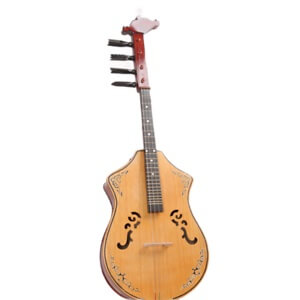Huobusi
 Huobusi is a stringed musical instrument from ancient times that is very popular among the Mongolian people. It can also be called "haobusi", "hebisi" or "hupoci", all of which are acceptable. At the beginning of the 1st century BC, the ethnic groups in northern China created this instrument with references to the musical instruments of Han ethnicity.
Huobusi is a stringed musical instrument from ancient times that is very popular among the Mongolian people. It can also be called "haobusi", "hebisi" or "hupoci", all of which are acceptable. At the beginning of the 1st century BC, the ethnic groups in northern China created this instrument with references to the musical instruments of Han ethnicity.
The traditional huobusi resembles the image of a spoon. It is 90cm long with 3 to 4 strings. The head is bending, and the handle is straight. The resonance box is covered with snakeskin. The tone has a rich flavor of the prairie of the northern China. The way to perform the instrument is quite the same as other stringed musical instruments. The performer uses his left hand to press the strings, and his thumb and index finger of the right hand to pluck them. Since it has a clear and bright sound with a soft tone, it is often used to play solo, ensemble and accompaniment.
The name of huobusi can be found in the history book of the 13 to 14th century AD. At that time, it was regarded as a national musical instrument, and was often performed at grandiose banquets. Later, it became popular with the civilians. After the Yuan dynasty was over, the governor of the Han ethnicity in Ming dynasty shared the same customs and habits with the Mongolians, but this instrument was excluded from the national level. It had not come back to the national level until the Qing dynasty in the 17th century, when the Mongolian customs prevailed again. It was played not only at the banquets but also the royal meetings and gatherings annually on February 1 and 5 of the lunar year.